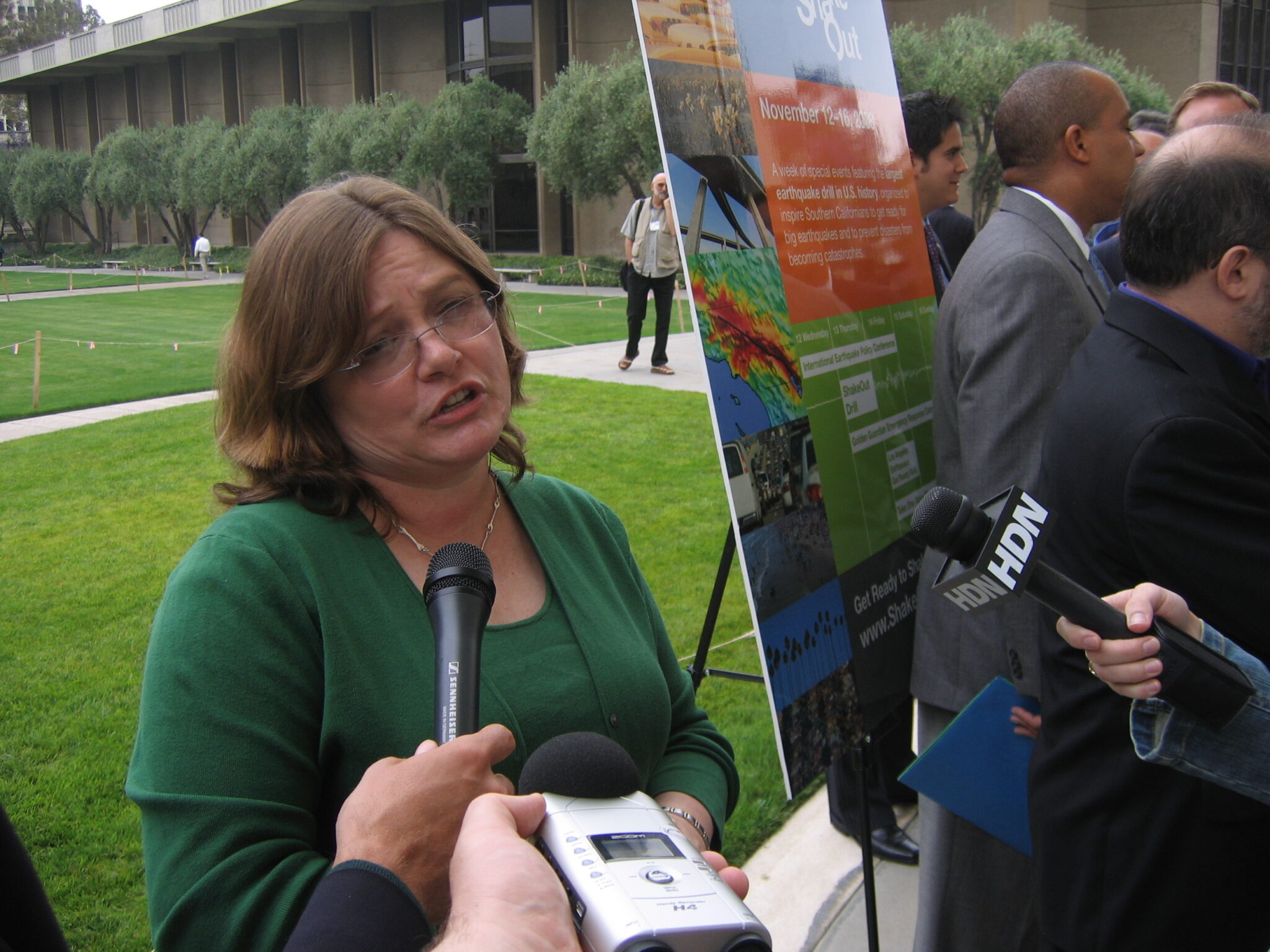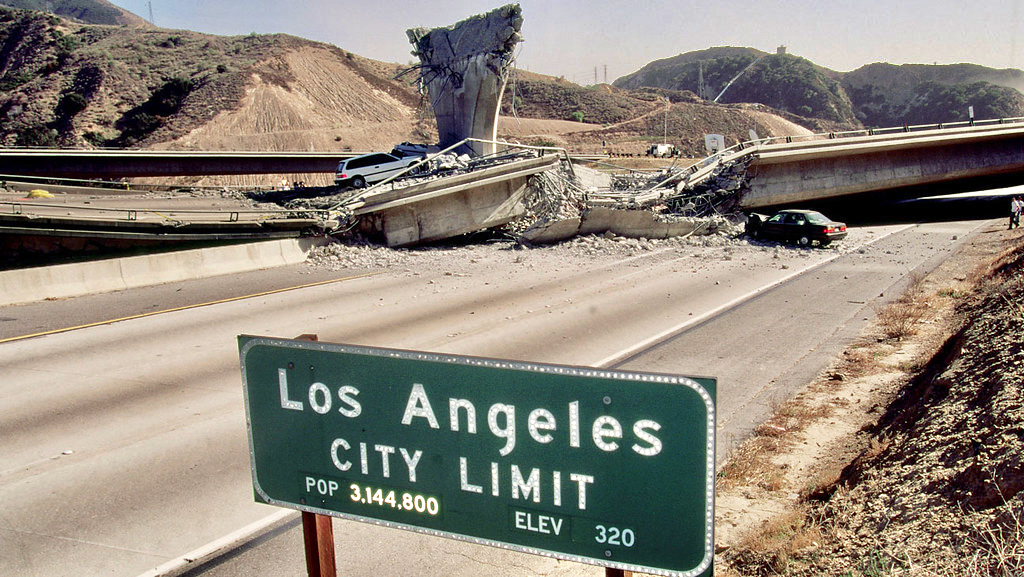If there are benchmarks we measure our lives by, then for Angelenos and Californians today is a big one, even if it wasn’t necessarily the fabled “Big One.” Today marks the 30th anniversary of the Northridge Earthquake.
In January 1994 I wasn’t living in California or on the west coast yet, though I soon would, and I’d only just had my first visit to Los Angeles a few months earlier in September 1993. My college buddy, now a San Diego-based AI entrepreneur, and I had flown out to visit two of our fellow college friends working in L.A. that summer. One was wrapping up an internship at Capitol Records before embarking on a career in the record industry, and the other was at the beginning of a writing career that has taken him from deep script research to writing screenplays and feature films to a truckload of industry awards. Both are still working in L.A. today.
At the time my buddy was returning to Ohio from a TV news internship at WCBS in New York City and getting ready to begin his senior year at Ohio University in Athens, while I had graduated 18 months earlier and was working as an overnight radio host — back when radio stations still had overnight hosts — at 102.9 WAZU in Dayton, Ohio. We played a classic rock format with a lot of Allman Brothers and Led Zeppelin, though at the time my big listening album was the Smashing Pumpkins’ Siamese Dream, and both Pearl Jam’s Vs. and Nirvana’s In Utero were about to be released. It was the 90s.
Our trip to Los Angeles was as fun as anyone’s first visit to L.A. should be. There were several long nights, followed by some incredibly bright mornings. We got familiar with the freeways that bind the city together, ate tacos and sushi, had a proper night out on the Sunset Strip at the Rainbow and Roxy, had another proper night out in Santa Monica, loaded up on free promotional CDs at the Capitol Records building, got an incredible tour of the Capitol Records studios from an engineer who had just recorded Frank Sinatra the week before for what became the Duets album, got a bonus tour of Les Paul’s legendary reverb chambers in the Capitol Records basement beneath Hollywood and Vine, and on the afternoon of Sept. 1, 1993, the four of us attended a taping of the Tonight Show. The guests included actor John Mendoza, The Proclaimers, and yes, Bill Cosby.
Jay Leno had recently taken over as the Tonight Show host, and my friend at Capitol had been to another taping of the show earlier that summer. He knew that Leno warmed up his own crowd ahead of the taping, and would often interact with the audience ahead of time. He also knew the stage manager kept a Polaroid camera nearby for when someone asked to have their photo taken with Jay. It was all part of the pre-show routine. So when Jay came out to warm up our crowd and asked if there were any questions, the first thing my friend did was rocket up his hand and asked for a photo. Working on a wireless mic, Jay said “sure, come on” and waved us around to the front of the set as the stage manager got the Polaroid.
Leno took one bemused look at us and knew we were from out of town. My heavy metal-reject appearance was no doubt a giveaway. He asked us our names and what we do. My friends all mentioned what they’d been working on that summer and were heading back to school in a week or two, and then Jay got to me. I told Jay I was living in Dayton and worked in “the radio business.” Without missing a beat, Jay put his arm around my neck, pivoted me toward the audience and asked the crowd, “You know what working in the radio business means in Dayton? ‘Do you want fries with that?!'”
The crowd went bananas. Huge laugh. Huge. Incredible! Wow, Jay Leno just made fun of me. How crazy is that?!! We took our seats and couldn’t believe the interaction, but not before a photo was taken of the four of us. I haven’t seen it in years. I’m sure we’re all thin.
A few months later on the morning of Jan. 17, 1994, I came off the air at the end of my shift at 6 a.m., did whatever post-shift production duties I’d been assigned, and went home. It was in the middle of winter, but the morning of the 17th was bright and sunny. I ate breakfast and was watching some of the morning TV news shows like Today and Good Morning America before going to bed.
Around 8 a.m. the networks began to go live with news of a major earthquake in the Los Angeles area. Having just been there, this was of interest. I’ve always had a layperson interest and appreciation of earthquakes and seismology, and obviously an earthquake in Los Angeles was a big deal, especially if it was a big quake. I called the morning guy at our station. He hadn’t heard the news so I told him to flip on the TV.
I was too small to remember the news coverage of the 6.6 magnitude San Fernando Earthquake in L.A. in February 1971, also known as the Sylmar Earthquake, but I’d read about it and knew it had occurred on the San Gabriel Fault near the base of the San Gabriel Mountains, and it had taken people by surprise because the fault was believed to have been inactive. Along with causing severe damage to the nearby Olive View Medical Center and Veterans Hospital, several of the Newhall Pass interchanges at the north end of the San Fernando Valley near Santa Clarita where the 5, 405, 14, and 210 freeways and Sierra Highway all intersect within a mile or so of each other were seriously damaged in that quake, with several collapsed ramps and roadbeds.
I did remember the more recent 5.9 Whittier Narrows Earthquake in October 1987 and seeing coverage of it on TV at the time, and of course the 6.9 Loma Prieta “World Series” Earthquake of October 1989 in the Bay Area happened while I was in college and was still fresh in everyone’s minds. More recently, in the spring of 1992, there had been a 6.1 earthquake in Joshua Tree in April, followed by the bigger 7.3 Landers Earthquake in June and a major 6.5 aftershock in Big Bear that same day, both of which were likely triggered by the earlier Joshua Tree quake.
I followed the story of what quickly became known as the Northridge Earthquake over the next several days. The epicenter was right beneath the city of Northridge in the San Fernando Valley, though the quake was felt as far away as San Diego, Lake Tahoe, Las Vegas, Phoenix, and Ensenada in Baja California. To a person, almost all my friends and colleagues in San Diego who felt the Northridge quake 30 years ago said it was the most violent jolt they ever felt — and they were all over 100 miles away from it.
The peak ground velocity (PGV), or greatest rate of ground movement during the shock, was recorded at the Department of Power and Water’s Grinaldi Receiving Station at the L.A. Reservoir in Granada Hills. Not only was it the fastest PGV ever recorded, it was the highest PGV ever recorded by a seismology instrument in an urban area in North America.
Some of the TV images and newspaper photos I remember quite well — no doubt you do too — including the many fires, the repeat collapse of some of the Newhall Pass-area freeway ramps and roadbeds just as in 1971, and the collapse of Interstate 10 near Culver City at La Cienega and Washington boulevards. The 10, or Santa Monica Freeway, was a freeway we’d used quite a bit on our visit to L.A. a few months earlier, so that stuck with me, and I followed the story of its rapid, and record-breaking, reconstruction over the following three months.
The human cost was grim, with 72 deaths ultimately attributed to the disaster. Having been to Los Angeles, even for a few days as a visitor, made the quake much more tangible to me because I was familiar with some of the areas affected, had met people who lived there, and had a general understanding and mental layout of the L.A. region. One of the more grisly incidents in the Northridge quake was the collapse of the Northridge Meadows Apartments. The building’s style of “tuck-under” parking is still a frequent site in apartment structures around Southern California, and 16 people died there as the result of what’s often called a “weak first floor” that was no match for the magnitude 6.7 earthquake that occurred beneath it.
The Northridge quake took on an additional creepy quality when it was determined the epicenter occurred on something called a blind-thrust fault, i.e. a fault that was hidden from view below the surface that moved in a vertical, angled motion, unlike the famous San Andreas Fault, which is visible from the surface and runs horizontally for hundreds of miles across California. The idea that there may be dozens, if not hundreds, of blind-thrust faults lurking beneath the L.A. Basin put many Angelenos into severe freakout mode, as the U.S. Geological Survey (USGS) and other agencies quickly began to consult old oil company surveys to map out some of these blind-thrust faults.
Dr. Lucy Jones of the U.S. Geological Survey had become somewhat famous two years earlier speaking with reporters about the Joshua Tree Earthquake with her sleeping son in her arms, and was a frequent site on TV in the hours and days after the Northridge quake. She later said, with understandable irritation, that “Northridge led to nothing,” in that no serious attempt was made to enforce a mandatory large-scale retrofit of vulnerable structures like the Northridge Meadows Apartments in the years since 1994, despite passage of one of the most stringent set of earthquake building rules in the nation by the city of Los Angeles in 2015.
Interestingly, I interviewed Dr. Jones for the media rollout of that policy in a news story I filed for Public News Service in 2014. I’d first met her in 2008 at the press event for the very first Great California Shakeout, and I’ve included our 2014 conversation at the top of this post.
If you’re interested in more, visit my post from October 2019 on the big earthquakes in Ridgecrest in the Mojave Desert that year.

Golden State Freeway banner photo courtesy of the U.S. Geological Survey (USGS), public domain.
Photo of Dr. Lucy Jones at the Great California Shakeout press event © 2008 Tommy Hough, all rights reserved.

